AMAZON multi-meters discounts AMAZON oscilloscope discounts
1. Introduction
Switchgear is used to connect and disconnect electric power supplies and systems. It is a general term which covers the switching device and its combination with associated control, measuring, protective and regulating equipment, together with accessories, enclosures and supporting structures.
Switchgear is applied in electrical circuits and systems from low voltage, such as domestic 220/240 V applications, right up to transmission networks up to 1100 kV. To meet this range of voltages and powers, a wide range of technology is needed, and this Section has been split into the main three subdivisions of low voltage, medium voltage (distribution) and high voltage (transmission) in order to deal with this wide range.
The main classes of equipment are:
- disconnectors, or isolators
- switches
- fuse-switch combinations
- circuit breakers
- earthing switches
A disconnector is a mechanical switching device which in the open position provides a safe working gap in the electrical system, to withstand normal working system voltage and any overvoltages which may occur. It is able to open or close a circuit if a negligible current is switched, or if no significant change occurs in the voltage between the terminals of the poles. Currents can be carried for specified times in normal operation and under abnormal conditions.
A witch is a mechanical device which is able not only to make, carry and interrupt current occurring under normal conditions in a system, but also to close a circuit safely, even if a fault is present. It must therefore be able to close satisfactorily Switch-fuse carrying a peak current corresponding to the short-circuit fault level, and it must be able to carry this fault current for a specified period, usually one or three seconds.
A fuse and a switch can be used in combination with ratings chosen so that the fuse operates at currents in excess of the rated interrupting or breaking capacity of the switch. Such a device is known as a fuse switch' if the fuseholder is also used as part of the main moving contact assembly, or a 'switch-fuse' if the fuse is a separate and static part of an assembly which includes the switch connected in series.
Figure 1 shows schematically the various combinations of fuse, switch and disconnector that are available.
Disconnector-fuse Switch I Disconnector Fuse-switch I Fuse-disconnector Switch-disconnector Switch-disconnector-fuse Fuse-switch-disconnector

Fig. 1 Summary of equipment definitions
A circuit breaker is a mechanical-switching device which is not only able to make, carry and interrupt currents occurring in the system under normal conditions, but also to carry for a specified time and to make and interrupt currents arising in the system under defined abnormal conditions, such as short-circuits. It experiences the most onerous of all the switching duties and is a key device in many switching and protection systems.
An earthing switch is a mechanical device for the earthing and short-circuiting of circuits. It is able to withstand currents for a specified time under abnormal conditions, but it is not required to carry normal service current. An earthing switch may also have a short-circuit making capacity.
2. Principles of operation
Since they perform the most arduous duty, circuit breakers are used here for the following brief description of switchgear operating principles.
The heart of a circuit breaker is the contact system which comprises a set of moving contacts, a set of fixed contacts, their current carrying conductors or leads and an opening mechanism which is often spring loaded.
The fixed and moving contacts are normally of copper, with sufficient size and cross-section to carry the rated current continuously. Attached or plated onto the copper are the contact tips or faces which are of silver or an alloy. The contact tip or face is the point at which the fixed and moving contacts touch, enabling the current to flow. It is therefore a requirement not only that a low contact junction resistance is maintained, but also that the contacts are not welded, destroyed or unduly eroded by the high thermal and dynamic stresses of a short-circuit.
As the device closes, the contact faces are forced together by spring or other pressure generated from the mechanism. This pressure is required in order to reduce the contact junction resistance and therefore the ohmic heating at the contacts; it also assists with the destruction or compaction of foreign material such as oxides which may contaminate the contact faces. The closing process is further assisted by arranging the geometry to give a wiping action as the contacts come together; the wiping helps to ensure that points of purely metallic contact are formed.
The breaking or interruption action is made particularly difficult by the formation of an arc as the contacts separate. The arc is normally extinguished as the current reaches a natural zero in the ac cycle; this mechanism is assisted by drawing the arc out to maximum length, therefore increasing its resistance and limiting the arc current.
Various techniques are adopted to extend the arc; these differ according to size, rating and application and this is covered in more detail in the following sections.
The interruption of a resistive load current is not usually a problem. In this case the power factor is close to unity. When the circuit breaker contacts open, draw an arc and interrupt the current, the voltage rises slowly from its zero to its peak following its natural 50 Hz or 60 Hz shape. The build-up of voltage across the opening contacts is therefore relatively gentle, and it can be sustained as the contact gap increases to its fully open point.
However, in many circuits the inductive component of current is much higher than the resistive component. If a short-circuit occurs near the circuit breaker, not only is the fault impedance very low, and the fault current at its highest, but also the power factor may be very low, often below 0.1, and the current and voltage are nearly 90 degree out of phase. As the contacts open and the current is extinguished at its zero point, the voltage tends instantaneously to rise to its peak value. This is illustrated in Fig. 2. This results in a high rate of rise of voltage across the contacts, aiming for a peak transient recovery voltage which is considerably higher than the normal peak system voltage. There is a risk under these circumstances that the arc will restrike even though the contacts are separating, and the design of the circuit breaker must take this into account.
3 Low-voltage switchgear
3.1 Switches, disconnectors, switch disconnectors and fuse combination units
(a) Construction and operation
These switches are categorized by the ability to make and break current to particular duties which are listed for ac applications in Table 1. The category depends upon a multiple of the normal operating current and an associated power factor.
In all these devices, the contacts are usually of silver-plated copper; it is unusual to find the alloy contact tips used in circuit breakers. The contact system, connecting copper-work and terminals are usually housed within a housing of thermoset plastic or of a thermoplastic with a high temperature capability. The mechanism of the switch may be located in a number of positions, but it is usual to mount it at the side of or below the contact system.
The switching devices may be fitted with auxiliaries which normally take the form of small switches attached to the main device. These auxiliary switches provide means of indication and monitoring the position of the switch.

Fig. 2 Circuit breaker recovery voltage in an inductive circuit

Table 1 Categories of duty and overload current ratings for switches,
disconnectors, switch disconnector and fuse combination units

Fig. 3 Main features of a fuse switch
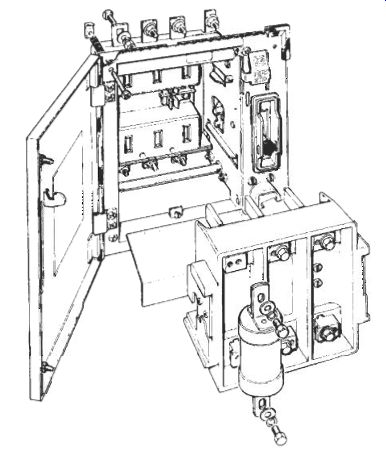
Fig. 4 Bill Sovereign fuse switch
disconnector.
There are switching devices that are motor assisted to open and close the contacts, and some have tripping devices incorporated into the mechanism to open the switch under circuit conditions outside the protective characteristics of the fuse.
Many types of fuselink can be accommodated on a switch fuse or a fuse switch.
In the UK, the bolted type is probably the most common, followed by the 'clip-in' type. There are many designs available to hold the clip-in fuselink within the switch molding. In continental Europe the DIN type fuselink is the most common; here the fuse tags are formed as knife blades to fit into spring-tensioned clips.
The construction of a fuse switch is illustrated generally in Fig. 3. It consists of a moving carriage containing the fuselinks, which is switched into and out of a fixed system containing the contacts and mechanism. The moving carriage is shown in Fig. 4; it consists of a plastic and steel framework with copper contacts and terminals onto which are mounted the fuselinks. This is normally a three-pole or four-pole construction. It is usual to be able to extract the moving carriage to facilitate the changing of fuselinks outside the switch. Removal of the carriage also ensures total isolation of the load from the supply. The moving carriage is moved in and out by a spring-charged mechanism that ensures a quick make and break of the contacts.
In a switch-fuse the fuselinks remain static; the simplest form is a knife blade contact in series with a fuselink. In the modem form of switch fuse the fuselinks are mounted on a plastic enclosure which contains the contacts and the mechanism to operate these contacts. The contacts are normally arranged on both load side and supply side of the fuselink in order to ensure that the fuse is isolated when the switch is in the off position. The contact system is driven by a spring-assisted mechanism which is usually designed to provide quick make and break operation independent of the speed at which the operator moves the on-off handle.
In its simplest form, the switch is a knife blade contact, but the modem switch would follow the form of the fuse switch without the fuselinks. Many manufacturers use a fuse switch or switch fuse with solid copper links in place of the fuselinks.
The disconnector also follows the construction of the switch, but it must be capable of providing complete isolation when the contacts are open. This usually requires the provision of adequate clearance and creepage distances between live parts.
The switch disconnector combines the properties of a switch and a disconnector; this is in most cases what a manufacturer would build for sale.
(b) Standards and testing
Switches, disconnectors, switch disconnectors and fuse combination units are designed to comply with the requirements of IEC 947-3 or EN 60947-3. This requires a combination of type tests and routine tests.
A sequence of type tests is required to prove compliance with the standard. This sequence includes the following key tests:
--the making and breaking switching capacity test, which shows that the device is suitable for extreme overload conditions of resistive, inductive or highly inductive loads.
The categories of duty and the current overload ratings have been shown in Table 1. The test is carried out by operating the device a number of times at the assigned rating.
--temperature-rise verification. This is carried out at the highest current rating of the device to prove that under full-load conditions in service the device will not damage cables, terminals and insulating materials or put operators at risk through contact with hot accessible parts. The limits of acceptable temperature rise are stipulated in the standard.
--the operational performance test. This is conducted to prove the mechanical and electrical durability of the device. A number of on-load and off-load switching operations are made, depending upon the make-break duty assigned by the manufacturer.
--dielectric verification to prove that the device has completed the sequence without damage to its insulation system.
A fuse switch or switch fuse is also proven by a fuse-protected short-circuit withstand (breaking) test. In this test, the fuselinks used have to be of the maximum rating, and with a breaking capacity assigned by the manufacturer. No damage such as welding of the contacts must occur to the switch as a result of this test. A fuse-protected making test is also carried out in which the switch is closed onto the declared rated short-circuit current.
A disconnector has to provide isolation properties and additional type tests are performed to prove these. In particular, a leakage current test is conducted after the main test sequence; maximum levels of acceptable leakage current are specified. In addition, the isolator handle is subjected to a force of three times the normal operation force necessary to switch the device off (within given minimum and maximum limits), the contacts of one phase being artificially locked in the off position and the test force being applied to open the switch. The on-off indicators of the disconnector must not give a false indication during and after this test.
Routine tests to be applied to all switch devices include an operational check in which each device is operated five times to check mechanical integrity. Also a dielectric test is carried out at a voltage which depends upon the rated voltage of the device. For a rated operating voltage of 380/415 V the dielectric test voltage is 2500 V.
3.2 Air circuit breakers and molded case circuit breakers
(a) Construction and operation
Both the air circuit breaker and the molded case circuit breaker (mccb) comprise the following features: a contact system with arc-quenching and current-limiting means a mechanism to open and close the contacts auxiliaries which provide additional means of protection and indication of the switch positions The modem air circuit breaker is generally used as an incoming device on the supply side of a low voltage switchboard, and it represents the first line of protection on the load side of the transformer. An example is shown in Fig. 5. In addition to the above features, it also includes: a tripping and protection system to open the circuit breaker under fault conditions (if required)
a means of isolating the device from the busbars usually an open construction, or the contact system housed in a plastic molding current ratings from 400 A to 6300 A The mccb may be used as an incoming device, but it is more generally used as an outgoing device on the load side of a switchboard. It is normally mounted into a low-voltage switchboard or a purpose-designed panel board. In addition to the three features listed at the start of this section, it also includes: an electronic or thermal/electromagnetic trip sensing system to operate through the tripping mechanism and open the circuit breaker under overload or fault conditions all parts housed within a plastic molded housing made in two halves current ratings usually from 10 A to 1600 A The basis of the main contact system has been explained in section 3.1. The fixed contacts are usually mounted on a back panel or within a plastic molding, and the moving contacts are usually supported on an insulated bar or within an insulated carriage.

Fig. 5 Air circuit breaker.
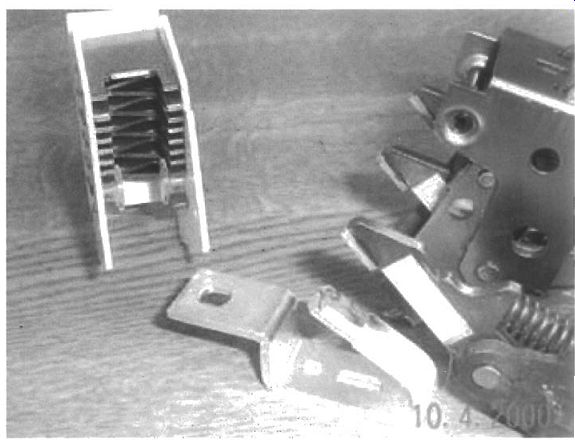
Fig. 6 Contact system and arc chute in an air circuit breaker
In addition to these main contacts, arcing contacts are provided. The arcing contacts generally comprise a silver-tungsten alloy which provides high electrical conductivity with excellent wear against arc erosion and good anti-welding properties. The arc contacts are positioned in such a way that they make first and break last during opening and closing of the contacts. Their purpose is to ensure that any arcing takes place on the arcing contacts before the main contacts touch; the arcing contacts can then break once the main contacts have been forced together. During opening, the sequence is reversed. This action protects the main contacts from damage by arcing.
Extinguishing of the arc is an important feature in all low-voltage switchgear. All air circuit breakers have devices to extinguish the arc as quickly as possible. It is well known that an arc, once formed, will tend to move away from its point of origin; by forming the contact system carefully, the magnetic field generated by the current flow is used to move the arc into an arcing chamber where its extinction is aided.
Within the arcing chamber are number of metal arc-splitter plates which normally have a slot or 'V' shape cut into them in order to encourage the arc to run into the arcing chamber. A typical arrangement is shown in Fig. 6. The plates are used to split the arc into a number of smaller arcs, having the effect of lengthening and cooling the arc. The arc is then extinguished when the voltage drop along it is equal to the voltage across the open contacts.
If the arc can be extinguished very quickly before the full prospective fault current is reached, the maximum current passed through the circuit breaker can be limited.
This current limiting is achieved if the arc is extinguished within 10 ms of the start of the fault, before the peak of the sinusoidal current waveform is reached. Many designs have been tried in an attempt to achieve current limiting. Many of these designs are based on forming the current-carrying conductors within the circuit breaker in such a way that the electromagnetic forces created by the currents force the arc into the arcing chamber very quickly. A particular development of this is to form 'blow-out' coils from the current-carrying conductors.
The opening and closing mechanism of an air circuit breaker generally uses the energy developed in releasing a charged spring. The spring may be charged manually or with the aid of a winding mechanism attached to a motor. The charge is usually held until a release mechanism is activated, and once the spring energy is released to the main mechanism, linkages are moved into an over-toggle mode to close the moving contacts onto the fixed contacts. The force of the main spring is also used to transfer energy into compressing the moving contact springs, and it is these springs which provide the energy to open the contacts when required.
Attached to and interfacing with the main mechanism is the tripping mechanism which is used to open the contacts. The means of tripping an air circuit breaker is a coil, which may be a shunt trip coil, an undervoltage coil or a polarized trip coil. The shunt trip coil is current operated and consists of a winding on a bobbin with a moving core at its center. When a current flows, the magnetic flux causes the core to move and this core operates the trip mechanism. An undervoltage coil is similar in construction, but the moving core is held in place by the magnetic flux against a spring; if the voltage across the winding falls this allows the spring to release the core and operate the trip mechanism. In the polarizing trip coil, the output of the coil is used to nullify the magnetic field from a permanent magnet which is set into the coil; when the coil is energized, the permanent magnetic field is overcome and using a spring energy a moving core is released to operate the trip mechanism.
The release coil receives its signal from the overcurrent detection device, which is usually an electronic tripping unit. This tripping unit has the capability to detect overloads and short-circuits, and it may be able to detect earth fault currents. The overload protection device detects an overload current and relates this to the time for which the current has flowed before initiating a trip signal; the time-current characteristic which is followed here is determined by the manufacturer within the guidelines of the standard. The general principles of time-current protection are explained more fully in Section 8, but a typical time-current characteristic is shown for convenience in Fig. 7. The short-circuit protection enables a high fault current to be detected and the circuit breaker to be opened in less than 20 ms. The short-circuit protection characteristics are usually adjustable in multiples of the full-load rated current, and they may incorporate a time interval which would usually be less than a second.

Fig. 7 Typical time-current characteristic curves
The mccb also incorporates an electronic trip device similar to that described above, but this may not include all the sophistication of the air circuit breaker system.
Some mccbs will include an electromechanical thermal trip and electromagnetic trip in place of the electronic trip unit. These trips are shown diagrammatically in Fig 7.8.
The electromechanical thermal trip consists of a heater and bimetal, the heater being part of the main current-carrying circuit. In overload conditions the heater causes deflection of the bimetal which is time related depending upon the current flow through the heater. The bimetal deflection results in operation of the trip mechanism and hence a time-current characteristic can be drawn for the circuit breaker. An electromagnetic trip usually comprises a U-shaped coil around the current-carrying circuit of the mccb, together with a moving pole piece. When a fault current passes, the magnetic flux within the U-shaped coil pulls in the pole piece and this movement is used to trip the circuit breaker.
(b) Testing and standards
Low-voltage air circuit breakers and mccbs are designed and tested according to the requirements of IEC 947-2 or EN 60947-2.
A series of type tests is carried out to prove compliance with the standard. This series of tests includes:
a short-circuit capability test. This determines the maximum short-circuit current the device can withstand, while after the test retaining the ability to pass full-load current without overheating and allow the circuit breaker limited use. This test is carried out in a short-circuit test laboratory able to deliver exactly the current specified in the standard; large generators and transformers are necessary for this work, making it expensive.
a short-time withstand test. This establishes that the circuit breaker can carry a short-circuit current for a period of time; in many cases this would be 50 kA for 1 s. A circuit breaker with this capability can be used as an incoming device to a distribution system. Based on the principles of co-ordination explained in Section 8, this allows other devices within the distribution system to open before the incoming circuit breaker, thereby not necessarily shutting off all of that distribution system.
an endurance test. This determines the number of open-close operations the circuit breaker can withstand before some failure occurs which means that the device will no longer carry its rated current safely. The tests are carried out with and without current flowing through the contacts.
opening during overload or fault conditions. This test verifies that the device opens according to the parameters set by the standard and those given by the manufacturer. It determines the time-current characteristic of the circuit breaker, an example of which has been shown in Fig 7.7.
a temperature rise test. This is carried out after all the above type tests. The standard specifies the maximum temperature rise permissible at the terminals and ensures that the device will be safe to use after short-circuits have been cleared and after a long period in service.
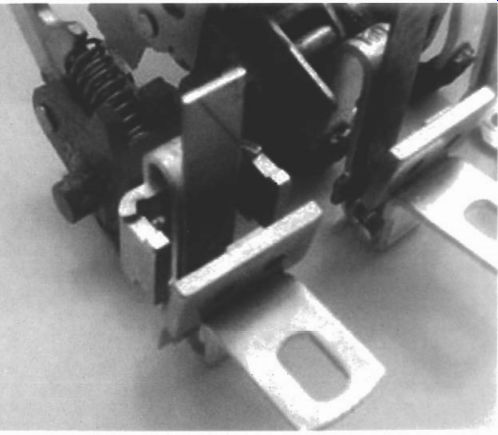
Fig. 8 Electromechanical and electromagnetic trips used in a mccb

Fig. 9 Miniature circuit breaker, external view Fig. 10 Principal
parts of an mcb
3.3 Miniature circuit breakers
Like the mccb, the miniature circuit breaker (mcb) has a contact system and means of arc quenching, a mechanism and tripping and protection system to open the circuit breaker under fault conditions.
The mcb has advanced considerably in the past 25 years. Early devices were generally of the 'zero-cutting' type, and during a short-circuit the current had to pass through a zero before the arc was extinguished; this provided a short-circuit breaking capacity of about 3 kA. Most of these early mcbs were housed in a bakelite molding.
The modern mcb is a much smaller and more sophisticated device. All the recent developments associated with molded case circuit breakers have been incorporated into mcbs to improve their performance, and with breaking capacities of 10 kA to 16 kA now available, mcbs are used in all areas of commerce and industry as a reliable means of protection.
Most mcbs are of single-pole construction for use in single-phase circuits. The complete working system is housed within a plastic molding, the typical external appearance of which being shown in Fig. 9. A schematic showing the principal parts of the mcb is shown in Fig. 10. The contact system comprises a fixed and a moving contact, and attached to each is a contact tip which provides a low-resilience contact junction to resist welding.
Modem mcbs are fitted with arc chutes consisting of metal plates which are held in position by insulating material. The arc chute does not necessarily surround the contact; in some designs arc runners are provided to pull the arc into the arc chute.
The tripping mechanism usually consists of a thermal-magnetic arrangement. The thermal action is provided by a bimetal with, in some cases, a heater. For ratings in the range 6-63 A the bimetal forms part of the current path, the heat generated within the bimetal itself being sufficient to cause deflection. The deflection is then used to activate the tripping mechanism. The characteristics of the bimetal are chosen to provide particular delays under certain overload or fault currents according to the required time-current characteristic. A high-resistance bimetal is used for low-current devices and a lower-resistance bimetal for high-current devices. In very low-current mcbs a heater may be incorporated around the bimetal in order to generate sufficient heat to deflect it.
The magnetic tripping element usually consists of a coil which is wrapped around a tube, there being a spring-loaded slug within the tube. Movement of the slug operates the tripping mechanism to open the mcb. It can also be used to assist in opening the contacts by locating the coil near to the moving contact. When a fault current flows, the high magnetic field generated by the coil overcomes the spring force holding the slug in position; the slug then moves to actuate the tripping mechanism and forces the contacts apart by striking the moving contact arm, For low mcb ratings the coil is formed from thin wire with many turns; for higher ratings the wire is thicker, with fewer turns. The magnetic trip is set by the manufacturer according to the required characteristics. These characteristics are defined in the standard and form 'types' which are shown in Table 2.
MCBs are designed and tested according to the requirements of IEC 898.

Table 2 Magnetic trip settings for mcbs
3.4 Residual current devices
The residual current device (rcd) is used to detect earth fault currents and to interrupt supply if an earth current flows. The main application is to prevent electrocution but rcds can also be used to protect equipment, especially against fire. The earth fault currents that operate an rcd can range from 5 mA up to many amperes. For typical domestic applications the typical trip current would be 30 mA. The rcd can be opened and closed manually to switch normal load currents, and it opens automatically when an earth fault current flows which is about 50 percent or more of the rated tripping current.
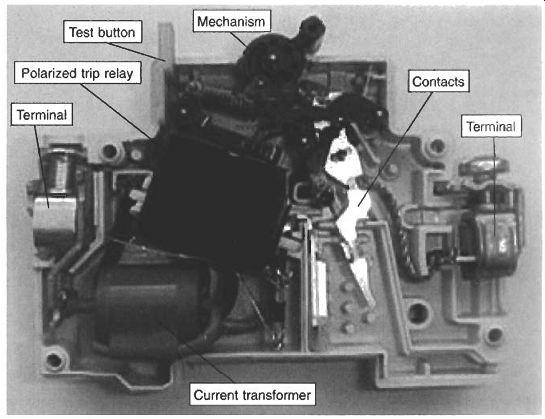
Fig. 11 Residual current device
The main features of an rcd are shown in Fig 11. The key component is a toroidal transformer, upon which the load current (live) and return current (neutral) conductors are wound in opposite directions. The toroid also carries a detecting winding. If no earth fault current is flowing then the load and return currents are equal. In this case the mmfs generated by the load and return current windings are equal; there is no resultant flux in the toroid and the detecting winding does not generate any current. When a fault current flows there is a difference between the load and return currents which generates a resultant flux in the toroid and induces a current in the detecting winding. The current generated in the detecting winding operates a relay which opens the main contacts of the rcd.
From a very small output the detecting winding has to produce sufficient power to operate the tripping mechanism. Two alternative methods are used. In the first method, the output signal from the detecting coil is electronically amplified and the second method uses a polarized relay operating on a sensitive mechanical trip mechanism. The operation of a polarized trip relay has already been described for circuit breakers in section 7.3.2(a); it is based on the magnetic output of a small coil nullifying the field from a permanent magnet, causing the release of an armature. The basic operation is illustrated in Fig. 12.
The operation of an rcd has here been described for single-phase operation, but it may also be applied in a three-phase application where typically it might be used in a light industrial system for protection against fire. There are two arrangements of a three-phase rcd. Either the three phases are wound around a current transformer, or the three phases and the neutral are wound onto a balancing transformer.
The rcd has only limited breaking capacity and it is not a replacement for overcurrent protection devices such as the mcb. The residual current breaker with overcurrent (rcbo) is now available; this is an rcd with an overcurrent tripping mechanism and enhanced contacts to cope with interruption of fault conditions.
RCDs are designed and tested according to the requirements of IEC 1008 and IEC 1009.
3.5 Standards
The leading international standards adopted for low-voltage switchgear are shown in Table 3.
4. Medium-voltage (distribution) switchgear
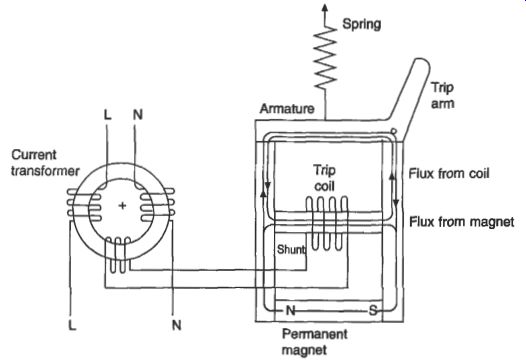
Fig. 12 Operation of polarized trip relay Table 3 International standards
Elating to low-voltage switchgear
Distribution switchgear, also commonly referred to as medium-voltage switchgear, is generally acknowledged to cover the range 1 kV to 36 kV. 72.5 kV and even 132 kV can be considered as distribution voltages rather than transmission voltages, and the equipment overlaps with high-voltage or transmission switchgear in this range.
Switchgear in the distribution-voltage range differs considerably from low-voltage switchgear. There are similarities with aspects of transmission switchgear, but many functions and practices are different.
4.1 Types of circuit breaker In the past, oil- and air-break devices have predominated, but now several alternative methods of arc interruption are used in distribution-voltage circuit breakers.
Early oil designs featured plain-break contacts in a tank of oil capable of withstanding the considerable pressure built up from large quantities of gas generated by long arcs.
During the 1920s and 1930s various designs of arc control device were introduced to improve performance. These were designed such that the arc created between the contacts produces enough energy to break down the oil molecules, generating gases and vapors which by the cooling and de-ionizing of the arc resulted in successful clearance at current zero. During interruption, the arc control device encloses the contacts, the arc, a gas bubble and oil. Carefully designed vents allow the gas to escape as the arc is lengthened and cooled. Figure 13 shows an axial-blast arc control device. The use of oil switchgear is reducing significantly in most areas of the world because of the need for regular maintenance and the risk of fire in the event of failure.

Fig. 13 Axial-blast arc control device
Sulphur hexaflouride {SF,) is the most effective gas for the provision of insulation and arc interruption. It was initially introduced and used predominantly in transmission switchgear, but it became popular at distribution voltages from the late 1970s.
The main early types of SF6 circuit breaker are known as 'puffer' types. These use a piston and cylinder arrangement, driven by an operating mechanism. On opening, the cylinder containing SF6 gas is compressed against the piston, increasing the gas pressure; this forces the gas through an annular nozzle in the contact giving a 'puff' of gas in the arc area. The gas helps to cool and de-ionize the arc, resulting in arc interruption at current zero. The dielectric properties of SF6 are quickly re-established in the heat of the arc, giving a rapid increase in dielectric strength as the voltage across the contacts begins to rise. The energy required to drive the puffer type of circuit breaker is relatively high, resulting in the need for a powerful mechanism.
Other designs of SF6 circuit breaker started to be introduced in the 1980s. These make more use of the arc energy to aid interruption, allowing the use of a lighter and cheaper operating mechanism. Whilst in the puffer design the compressed SF6 is made to flow over an arc which is basically stationary, these newer designs move the arc through the SF6 to aid interruption. In the rotating-arc SF6 circuit breaker a coil is wound around the fixed contact. As the moving contact withdraws from the fixed contact the current is transferred to an arcing contact and passes through the coil. The current in the coil sets up an axial magnetic field with the arc path at right angles to the magnetic flux, and rotation of the arc is induced according to Fleming's left-hand rule (see Section 2, eqn 2.16). The arc rotation is proportional to the magnitude of the current. Careful design is required in order to ensure an adequate phase shift between the flux and the current to maintain adequate movement of the arc as the current falls towards its zero crossing. The operation of a rotating-arc interrupter is illustrated in Figs 14 and 15.
Fixed contact ring
The arc has been extended towards the coil axis by transverse movement of the contact bar. It is shown after transfer to the arcing tube and consequent production of the magnetic field. It is thus in the best plane to commence rotation
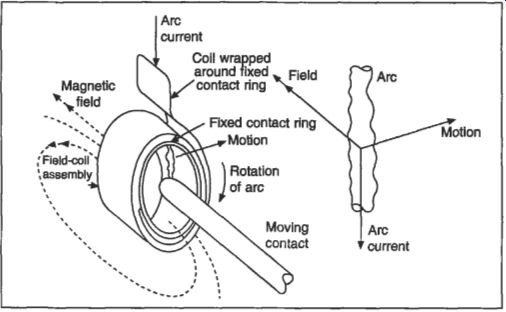
Fig. 14 Operation of a rotating-arc SF6 interrupter
Other types of self-extinguishing circuit breaker use an insulating nozzle which is similar to that in a puffer breaker, but with a coil to produce a magnetic field for moving the arc. The thermal energy in the arc is used to increase the local pressure.
This results in arc movement which again is proportional to the current, and successful interruption follows. In some designs a small puffer is also used to ensure there is enough gas flow to interrupt low levels of current, where the thermal energy in the arc is relatively low.
The various types of SF6 high-voltage switchgear are referred to in section 5.2, and Fig. 24 shows the main configurations.
The main alternative to the SF6 circuit breaker in the medium-voltage range is the vacuum interrupted: This is a simple device, comprising only a fixed and moving contact located in a vacuum vessel, but it has proved by far the most difficult to develop. Although early work started in the 1920s, it was not until the 1960s that the first vacuum interrupters capable of breaking large currents were developed, and commercial circuit breakers followed about a decade later.
Development of a spiral arc. The arc is motivated to move sideways but this tendency is limited by the shape of the electrodes and it develops quickly into a spiral with each element tending to move sideways as shown by the arrows
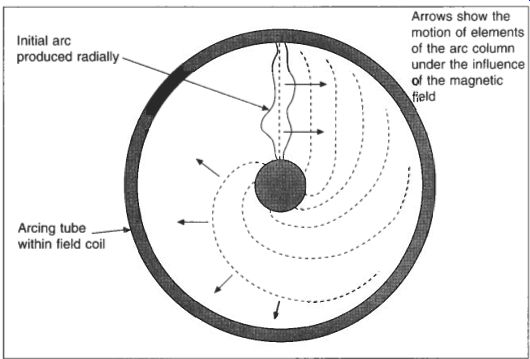
Fig. 15 Operation of a rotating-arc SFs interrupter
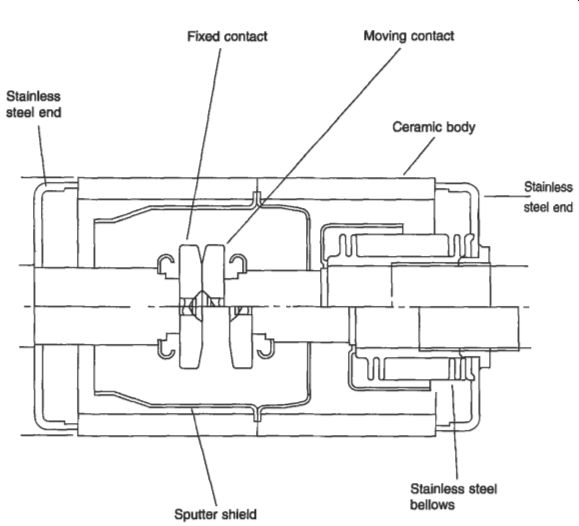
Fig. 16
Typical vacuum interrupter
The principle of operation of a vacuum interrupter is that the arc is not supported by an ionized gas, but is a metallic vapor caused by vaporization of some of the contact metal. At current zero the collapse of ionization and vapor condensation is very fast, and the extremely high rate of recovery of dielectric strength in the vacuum ensures a very effective interrupting performance. The features of a vacuum interrupter which are key to its performance are the contact material, the contact geometry and ensuring that the envelope (a glass or ceramic tube with welded steel ends) remains vacuum-tight throughout a working life in excess of 20 years. Even today, specialized manufacturing techniques are necessary to achieve this. A typical vacuum interrupter is shown in Fig. 16.
The circuit breaker is located within a switchgear housing, some types of which are described later. The main insulation in the housing is usually air, although some designs now have totally sealed units filled with SF6 gas. Structural isolation is required to support current-carrying conductors; this is normally some type of cast resin. Thermoplastic materials which can be injection molded are often used for smaller components, but larger items such as bushings which are insulation covered are usually made from thermosetting materials such as polyurethane or epoxy resin mixed with filler to improve its mechanical and dielectric properties.
4.2 Main classes of equipment
(a) Primary switchgear
Primary substations up to 36 kV are usually indoor, although they can be outdoor where space is not a problem. Indoor equipment is usually metal enclosed, and it can be subdivided into metal-clad, compartmented and cubicle types. In the metalclad type, the main switching device, the busbar section and cable terminations are segregated by metal partitions. In compartmented types the components are housed in separate compartments but the partitions are non-metallic. The third category covers any form of metal-enclosed switchgear other than the two described.

Fig. 16 Typical vacuum interrupter

Fig. 17 Section of vertically isolated, horizontally withdrawn switchgear
The vertically isolated, horizontally withdrawn circuit breaker is the traditional arrangement in the UK or UK-influenced areas. This originates from the bulk-oil circuit breaker, for which there was a need for easy removal for frequent maintenance, but manufacturers have utilized the already available housings to offer vacuum or SF6 circuit breakers as replacements for oil circuit breakers, or even for new types to this design. The design also provides convenient earthing of the circuit or busbars by alternative positions of the circuit breaker in the housing; this is achieved by disconnecting the circuit breaker, lowering it from its service position, moving it horizontally and then raising and reconnecting the connections between the busbar or cable and earth. A typical section is shown in Fig. 17.
Horizontally isolated, horizontally withdrawn equipment has been used extensively in mainland Europe, with air-break, small oil volume and latterly with SF6 and vacuum circuit breaker truck designs. A section of this type of switchgear is shown in Fig. 18. Since the circuit breaker cannot be used as the earthing device in this design, integral earthing switches or portable earthing devices are required.
Fixed-position circuit breakers were introduced in the 1970s; these depart from the withdrawable arrangements and are based on a 'sealed-for-life' concept. Due to the early problems with vacuum interrupters, some users were reluctant to accept fixed-position vacuum switchgear, but now that excellent long-term reliability of vacuum interrupters has been established, newer designs have been introduced again recently. Several arrangements in which the housing is completely sealed and filled with SF6 as a dielectric medium are now available and an example is shown in Fig. 19. Because of the compact dimensions that SF6 permits these are gaining popularity, particularly at 36 kV, where there can be a cost advantage not only in the price, but also in the reduced size of the equipment and the substation required.
(b) Secondary switchgear
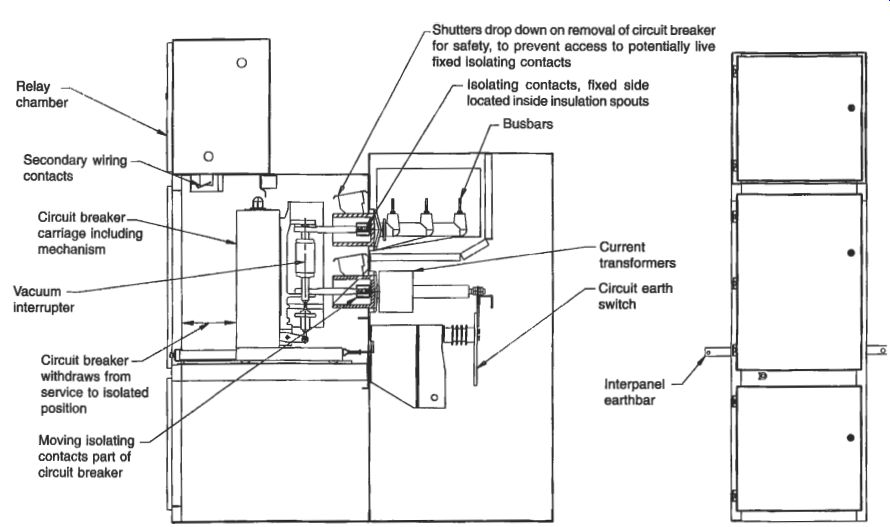
Fig. 18 Section of horizontally isolated, horizontally withdrawn switchgear
1 Drive for circuit-breaker and disconnector/ 5 Busbar compartment 2 Circuit-breaker compartment 7 Current transformer 3 Vacuum interrupter 8 Connecting cable 4 Disconnector/earthing switch blades 9 Cabinet for control and auxiliary earthing switch with control panel 6 Busbar (in position 'Disconnector MADE) devices (low-voltage cabinet)

Fig. 19 Section of 36 kV SF6 gas-insulated switchgear (courtesy ALSTOM
TLD)
Secondary distribution switchgear is that which is connected directly to the electrical utility transformers which provide low-voltage supplies to customers. The systems distributing power from the primary substations can be conveniently divided into overhead circuits and underground cable networks.
Most faults on overhead systems are caused by lightning strikes, branches brushing the conductors, clashing of conductors in high wind, or large birds bridging the lines; they are usually transient in nature. In most cases the fault duration is short and the circuit breakers used in these circuits, known as reclosers, are programmed to close again a very short time after they have opened. This allows the fault to be cleared with a minimum of disruption to consumers. It is normal to program the recloser to open then close up to four times in order to allow time for the fault to disappear.
If after this time the fault is still present, it is assumed that the fault is not transient; the recloser then locks out and the faulty section of line is isolated. A recloser normally controls several circuits. An 11 kV pole-mounted auto-recloser is shown in Fig. 20. Reclosers are available with SF6 and vacuum interrupters; the equipment used in conjunction with reclosers are switches and sectionalizers, which can be air-break switches, vacuum or SF6 devices, expulsion fuses and off-load switching devices.

Fig. 20 11 kV pole-mounted auto-recloser
Most urban areas in the UK and Europe are supplied by underground cable. In this case the step-down transformer (for example, 11 000/415 V) which supplies a consumer circuit is connected to a protective device such as a fuse switch or circuit breaker in a ring. A simplified distribution network with the main components is shown in Fig. 21. The 'ring main unit' usually has two load-break switches with the control protective device combined into a single unit. In the UK this type of unit is ruggedly designed for outdoor use, but in continental Europe indoor designs are more normal.
The traditional oil-filled unit has been replaced largely by SF6 equipment over recent years. The ring main unit has normally been manually operated with a spring-operated mechanism to ensure that its operation is not dependent on the force applied by the operator. However, as utilities press to improve the reliability of supplies to consumers and to reduce the time lost through outages caused by faults, the use of automatically operated motor-driven spring mechanisms is now on the increase.
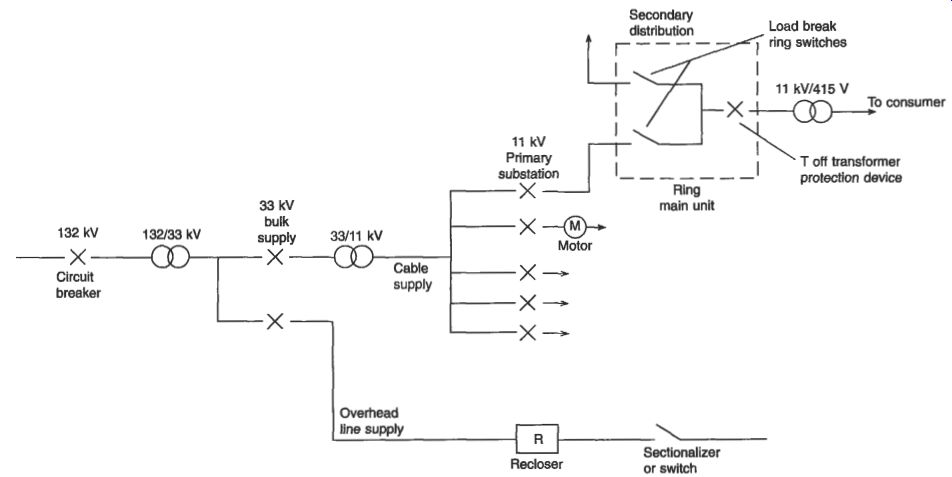
Fig. 21 Simplified distribution network showing the main switchgear
components

Table 7A co-ordination of rated values for circuit breakers, taken from
IEC.56
4.3 Rating principles
The main consideration in the choice of switchgear for a particular system voltage is the current it is capable of carrying continuously without overheating (the rated normal current) and the maximum current it can withstand, interrupt and make onto under fault conditions (the rated short-circuit current). Studies and calculations based on the circuits of interest will quantify these parameters. The switchgear rating can then be chosen from tables of preferred ratings in the appropriate standard, such as IEC 694 and IEC 56. Table 4 shows figures taken from IEC 56 showing the co- ordination of rated values for circuit breakers. Ratings vary commonly from less than 400 A in a secondary system to 2000 A or more in a primary substation, with fault currents of 6 kA in some overhead line systems up to 40 kA and above in some primary circuits.
The standards also specify overvoltages and impulse voltages which the switchgear must withstand. Normal overvoltages which occur during switching or which may be transferred due to lightning striking exposed circuits must be withstood. The switchgear also needs to provide sufficient isolating distances to allow personnel to work safely on a part of the system that has been disconnected. The lightning impulse withstand voltage and the normal power frequency withstand voltage are specified relative to the normal system voltage in the standards.
4.4 Test methods
Type tests are performed on a single unit of the particular type and rating in question.
They are performed to demonstrate that the equipment is capable of performing the rated switching and withstand duties without damage, and that it will provide a satisfactory service life within the limits of specified maintenance. The main type tests are:
-- dielectric tests. Lightning impulse is simulated using a standard waveshape having a very fast rise time of 1.2 ps and a fall to half value of 50 ps. Power frequency tests are performed at 50 Hz or 60 Hz. The method of performing the tests is detailed in standards, for instance IEC 60, 'Guide to high voltage testing techniques'. This requires the switchgear to be arranged as it would be in service. If outdoor rated, the tests need to be carried out in dry and wet conditions, the latter using water of specified conductivity which is sprayed onto the equipment at a controlled rate during application of the high voltage.
--temperature rise tests. Again the switchgear is arranged in its service condition, and the normal continuous current is applied until the temperature of the main components has stabilized. The final temperature, measured by thermocouples, must not exceed values stated in the specifications; these values have been chosen to ensure that no deterioration of metal or insulation is caused by continuous operation.
--short-circuit and switching tests. These are conducted over a range of currents from 10 percent to 100 percent of the short-circuit rating. The tests are at low power factor, which represents the most onerous switching conditions seen in service. The different levels represent short-circuits at various points in the system, from close to the circuit breaker terminals to a long distance along the cable or line. Whilst the current to interrupt varies with these positions. another major factor is the rate of rise of the transient recovery voltage appearing across the circuit breaker contacts; this can have a significant influence on the circuit breaker performance and it plays a key part in the design. The ability to interrupt the short-circuit current with a decaying dc component superimposed on the power frequency must also be demonstrated. The decrement or rate of decay of the dc voltage is specified in the standards, but the dc component which is present when the contacts open depends upon the opening time of the circuit breaker (it being reduced if the opening time is long). Figure 22 shows the determination of short-circuit making and breaking currents and of the dc component. Circuit breakers must also be tested when closing onto a fault condition, and then carrying the full short-circuit current for a specified period, usually one or three seconds.
-- mechanical endurance test. To demonstrate that the equipment has a satisfactory life, this test is performed over a specified number of operations which depends upon the type of equipment and duty; the number of open-close operations can vary from 1000 to 10 000. The tests are carried out without electrical load, but at the rated output of the mechanism of the device.
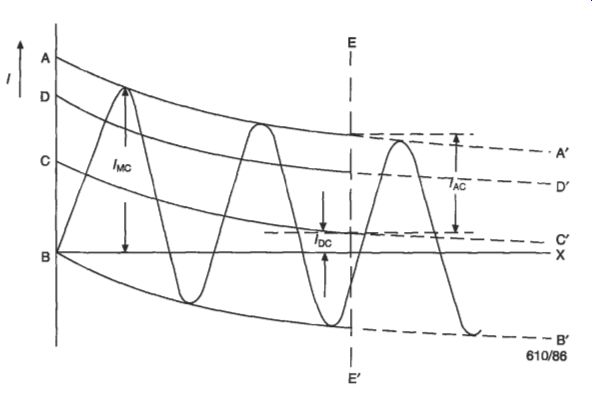
Fig. 22 Determination of short-circuit making and breaking currents
and of dc component
Routine tests are performed by the manufacturer on every unit of switchgear to ensure that the construction is satisfactory and that the operating parameters are similar to the unit which was subjected to the type test. These tests are specified in the standards, and the minimum performed will include the following: power frequency voltage withstand dry tests on the main circuit voltage tests on the control and auxiliary circuits
0 measurement of the resistance of the main circuit mechanical operating tests
4.5 Commissioning and maintenance Switchgear is usually transported in sections which need to be carefully erected and connected together at the substation.
Commissioning tests are performed after installation; these are necessary to ensure that the connections are sound and that the equipment is functioning satisfactorily.
These tests will normally include checks of current and voltage transformers, checking of the protection scheme, circuit breaker operation and high-voltage withstand tests.
With the demise of oil-filled switchgear the requirement for maintenance has been significantly reduced. SF6 and vacuum circuit breakers which are 'sealed for life' should require no servicing of the interrupting device. Manufacturers provide instructions on simple inspection and servicing of other parts of the circuit breaker; this is usually limited to cleaning, adjustment and lubrication of the mechanism.
4.6 Standards
Some of the commonly used standards and specifications for distribution switchgear are given in Table 5.

Table 5 Standards and specifications for distribution switchgear
5. High-voltage (transmission) switchgear
5.1 System considerations
The transmission of high powers over long distances necessitates the use of High (HV), Extra High (EHV) or Ultra High (UHV) voltages. Historically these voltages were classed as 72.5 kV and above. The lower voltages were introduced first, and as the technologies have developed these have increased so that now the highest transmission voltages being used are 1100 kV. For long transmission distances it is also possible to use dc systems; these have particular advantages when two systems are to be connected, but they are beyond the scope of this section, which considers only ac transmission switchgear.
In the UK the 132 kV system was first established in 1932, and subsequent growth has required expansion of the system up to 275 kV (1955) and 420 kV (1965). Other countries have developed similarly, so a multiple voltage transmission system exists in virtually every major electricity-using nation.
In recent years there has been some harmonization of the rated voltages of transmission systems, the agreed levels set down in IEC 694 being 72.5, 100, 123, 145, 170, 245,300, 362,420,550 and 800 kV. Systems will be operated at a variety of nod voltage levels such as 66, 132,275 and 400 kV, but the maximum system operating voltage may be higher than these nominal ratings, so the next highest standard value will be selected as the rated voltage of the system.
In order to connect, control and protect these transmission systems it is necessary to use switchgear of various types and ratings.
A switchgear installation which allows the connection and disconnection of the interconnecting parts of a transmission system is referred to as a substation. A substation will include not only the switchgear, but also transformers and the connections to overhead lines or cable circuits. The main functional elements of the switchgear installation in a substation are circuit breakers, switches, disconnectors and earthing switches. Some of the most common configurations for substations are illustrated in Fig. 23.
Switching conditions on transmission systems are similar in principle to those on distribution systems, with a requirement to interrupt normal load currents, fault currents and to undertake off-load operations. Because of the different circuit parameters in transmission and distribution networks, the switching duties impose particular requirements which have to be taken into account during the design and type testing of switchgear equipment. A particular requirement for transmission is the ability to deal with the onerous transient recovery voltages which are generated during interruption of faults on overhead lines when the position of the fault is close to the circuit breaker terminals; this is defined in IEC 56 as the short line fault condition. A further requirement is the energization of long overhead lines, which can generate large transient overvoltages on the system unless countermeasures are taken.
5.2 Types of circuit breaker
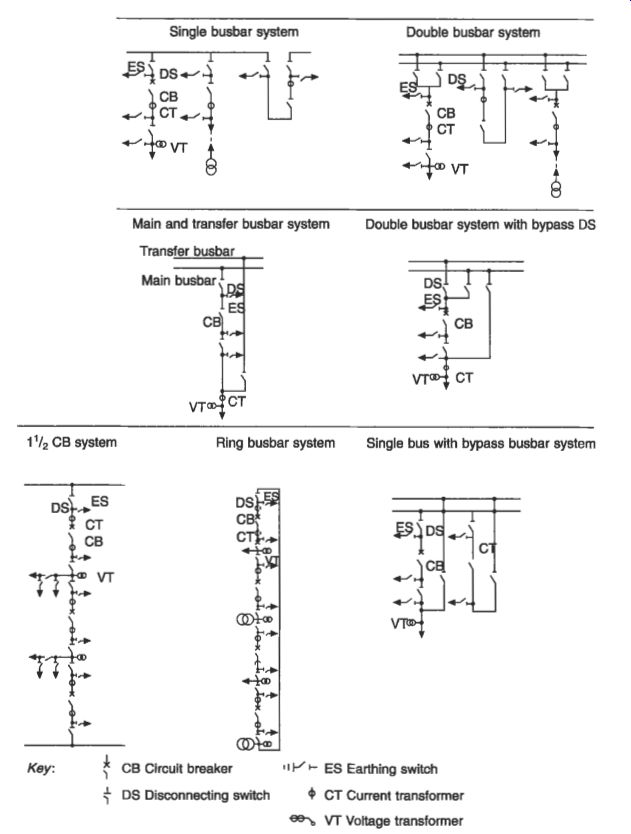
Fig. 23 Examples of busbar configurations for high-voltage substations
The first designs of transmission circuit breaker used minimum-volume oil interrupter technology similar to that which had been developed for distribution switchgear.
The 1940s saw the development and introduction throughout the world of air- blast circuit breakers. These devices used compressed air at pressures up to 1200 psi, not only to separate the contacts but also to cool and de-ionize the arc drawn between the contacts. Early air-blast designs used interrupters that were not permanently pressurized, and reclosed when the blast was shut off. Isolation was achieved separately by a series-connected switch which interrupted any residual resistive and/or capacitive grading current, and had the full rated fault-making capacity.
The increase of system voltages to 400 kV in the late 1950s coincided with the discovery, investigation and specification of the kilometric or short line fault condition.
Air-blast interrupters are particularly susceptible to high rates of rise of recovery voltage (RRRV), and parallel-connected resistors are needed to assist interruption.
At the increased short-circuit current levels of up to 60 kA which were now required, parallel resistors of up to a few hundred ohms per phase were required, and the duty of breaking the resistor current could no longer be left to the series-connected air switch. To deal with this, permanently pressurized interrupters incorporating parallel-resistor switching contacts were used. The original pressurized-head circuit breakers used multiple interrupters per phase in order to achieve the required fault-switching capacity at high transmission voltages; 10 or 12 interrupters were used for 400 kV. These were proved by direct unit testing at short-circuit testing stations, each having a direct output of 3 GVA. It was in fact the ability to test which determined the number of interrupters used in the design of a circuit breaker.
The introduction of synthetic testing methods increased the effective capacity of short-circuit testing stations by an order of magnitude, and this allowed the proving of circuit breakers having fewer interrupters. 400 kV air-blast circuit breakers with only four or six interrupters per phase were being supplied and installed up to the late 1970s.
The next step-change in technology occurred with the introduction of SF, circuit breakers. The merits of electronegative gases such as SF6 had long been recognized, and freon had been used in the late 1930s to provide the primary insulating medium in 33 kV metalclad switchgear installed in two UK power stations. The reliability of seals was a problem, and it was only during the nuclear reactor program that sufficiently reliable gas seals were developed to enable gas-insulated equipment to be reconsidered.
The first practical application of SF6 in switchgear was as the insulating medium for instrument transformers in transmission substations in the late 1950s and early 1960s. These were quickly followed by the use of SF6 not only as an insulating medium but also as the means of extinguishing arcs in circuit breakers. The first generation of SF6 circuit breakers were double-pressure devices which were based on air-blast designs, but using the advantages of SF6. These double-pressure designs were quickly followed by puffer circuit breakers which have already been described in section 4.1. Puffer circuit breakers, now in the form of second or third generation of development, form the basis of most present-day transmission circuit breaker designs. Figure 24 illustrates the various forms of SF6 interrupter.
5.3 Main classes of equipment
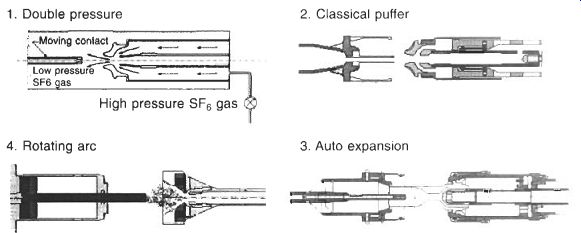
Fig. 24 Various forms of SF, interrupter [1. Double pressure 2. Classical
puffer 3 Auto expansion]
Transmission substations may be built indoors, or outdoors, but because of the space required it is usually difficult to justify an indoor substation. The strongest justification for an indoor substation is the effect of harsh environments on the design, operation and maintenance of the equipment.
The two main types of transmission switchgear currently available are conventional or Air-Insulated Switchgear (AIS) and gas-insulated metal-enclosed switchgear.
(a) Conventional or Air-Insulated Switchgear (AZS)
Here the primary insulating medium is atmospheric air, and in the majority of AIS the insulating elements are of either solid or hollow porcelain.
In circuit elements such as disconnectors and earthing switches, where the switching is done in air, the insulators are solid, and provide not only physical support and insulation, but also the mechanical drive for the elements. Examples of disconnectors and earth switch arrangements are shown in Fig. 25. The choice of disconnector design is dependent on the substation layout and performance requirements.
--------
Center break disconnector; Rotating center post disconnector; Pantograph disconnector; Semi-pantograph disconnector; Vertical break disconnector; Knee joint disconnector; Earthing switch

Fig. 25 Examples of disconnector and earth switch arrangements
-----------
Equipment such as circuit breakers which need an additional insulating or interrupting medium use hollow porcelain insulators that contain the active circuit elements in the appropriate insulating medium. As previously outlined, initial AIS installations used oil as the insulating and interrupting medium, which in many cases was replaced by the use of compressed air, and modem designs almost always use SF, gas.
The layout of a substation is governed by the need to ensure that air clearances meet the dielectric design requirements, including conditions when access is required to the substation for maintenance. Rules for the minimum clearances and the requirements for creepage distances on the external porcelain insulators are contained in the standards. For locations with atmospheric pollution it is necessary to provide extended creepage distances on insulators. Guidelines for the selection of creepage distance are given in IEC 815.
A recent development in AIS technology is the use of composite insulators for functional elements in place of the traditional porcelain. There is a risk of explosion with porcelain insulators when they are filled with insulating gas if a mechanical fault occurs with the equipment. A composite insulator consists of silicone rubber sheds on a filament glass-fiber tube; it is not brittle and will not explode if the insulator is ruptured. Composite insulators are now being used on instrument transformers and circuit breakers for AIS, and their use is likely to become more common.
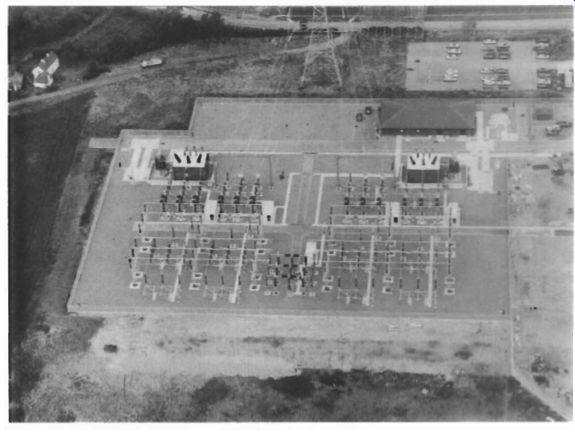
Fig. 26 Example of an AIS substation
An example of an outdoor AIS substation is shown in Fig. 26.
(b) Gas-insulated metal-enclosed switchgear
In metal-enclosed switchgear there is an external metal enclosure which is intended to be earthed; it is complete except for external connections. The earliest transmission metal-enclosed equipment used oil as the insulating medium, but since the introduction of SF,, all transmission metal-enclosed switchgear is based on SF6 as the insulating medium.
The main significance of the Gas-Insulated Substation (GIS) principle is the dramatic reduction of insulating clearances made possible by SF,, resulting in much more compact substation layouts. GIS are easier and more economic to accommodate where land use is critical, such as in many urban areas. It also offers considerable advantages in applications where environmental pollution is severe, such as in coastal, desert or heavily industrialized areas. Environmental conditions can also influence the need for maintenance of the switchgear and the implementation of that maintenance; GIs is so compact that transmission substations can be indoor, reducing the maintenance problems considerably. The greater reliability of GIS is another factor which is encouraging its increased application.
GIS switchgear is generally of modular design. All individual elements such as busbars, disconnectors, instrument transformers and circuit breakers are contained in interconnecting earthed enclosures filled with SF, at up to 7 bar. At the highest voltage levels, the three phases are housed in separate phase-segregated enclosures.
At the lower voltages it is common for all three phases to be housed in the same enclosure and with some designs this philosophy is extended up to 300 kV. Because of the possibility of heating effects from induced currents it is normal for phase- segregated designs to use non-magnetic materials (typically aluminum) for the enclosures, but for phase-integrated designs it is possible to use magnetic steels for some ratings without overheating constraints.
An example of a GIS substation is shown in Fig. 27.
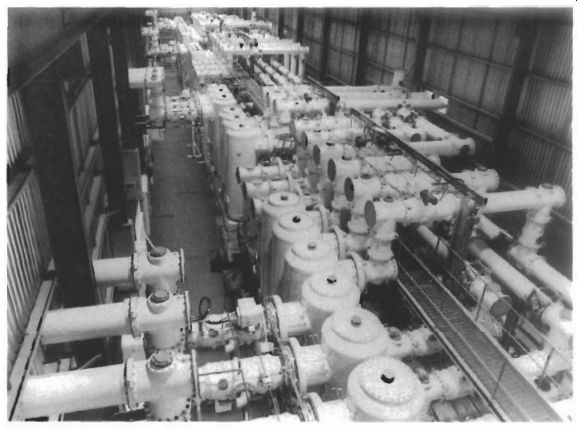
Fig. 27 Example of a GIS substation
5.4 Rating principles
As for distribution switchgear, the main consideration in the choice of rating for a particular system is the rated normal current and the rated short-circuit current.
Power system studies using load flow and transient analysis techniques will establish the values of the parameters for individual systems. It is also necessary to select lightning impulse rated values from the range of standard values specified in standards (as for distribution switchgear) and to specify for transmission systems with a rated voltage of 300 kV and above a rated switching impulse withstand voltage. The rated switching surge voltage level is defined as the peak voltage of a unipolar standard 250/2500 ps waveform; this represents the transient voltages which are generated by the operation of circuit breakers when switching overhead lines, shunt reactors and other circuits.
An important consideration in the choice of equipment ratings for transmission systems is insulation co-ordination. Insulation co-ordination is the selection of the electric strength of equipment and its application in relation to the voltages which can appear on the system taking into account the characteristics of any protective devices, so as to reduce to an economically and operationally acceptable level the probability that the resulting voltage stresses imposed on the equipment will cause damage to the equipment or affect continuity of service. For system voltages up to 300 kV, experience has demonstrated that the most important factor in determining system design is the stress due to lightning; for voltages over 300 kV the switching overvoltage increases in importance. It is now common to use metal oxide surge arrestors (MOA) to limit lightning overvoltage levels on transmission systems. In addition, the MOA can in many cases provide adequate limitation of switching overvoltages, but for longer overhead lines it may be required to use a circuit breaker with controlled (or point-on-wave) switching in order to keep overvoltages at acceptable levels. The traditional technique of using circuit breakers with parallel pre-insertion resistors is now being replaced by the use of the MOA and controlled switching.
5.5 Test methods
It is a requirement of international standards that switchgear must be so designed and manufactured that it satisfies the test specifications with regard to its insulating capacity, switching performance, protection against contact, current-carrying capacity and mechanical function. Evidence of this is obtained by type testing a prototype or sample of the switchgear. In addition, routine tests are performed on each individual item of switchgear manufactured, either on completed or sub-assembled units in the factory or on site.
Type tests are performed on transmission switchgear in a similar manner to those applied to distribution switchgear (see section 4.4), but because of the difference in rated values the necessary test values, the test equipment and techniques differ in detail. Some tests which are specific to transmission switchgear are: dielectric rests. In addition to lightning impulse and power frequency tests it is necessary to perform switching impulse tests for equipment with a rated voltage above 300 kV. short-circuit and switching rests. The test parameters for transmission equipment involve much higher energy requirements than for distribution equipment, so special techniques have been developed over the years. To provide the high voltage and high currents needed for transmission switchgear, it is usual to provide a 'synthetic' test source where the high voltage and high currents are provided in the same test from different sources.
Routine tests are performed on all switchgear units manufactured, or on subassemblies, to ensure that the performance of the factory-built unit will match that of the type- tested unit. AIS is normally fully assembled in the factory and routine tested as a complete functioning unit. Routine tests will include mechanical operations to check operating characteristics, resistance checks of current-carrying paths, tests on control and auxiliary circuits and power-frequency withstand tests to verify insulation quality.
For GIs, particularly at higher voltage levels, it is not practical to assemble fully a complete installation in the factory. Therefore subassemblies of GIS or transportable assemblies are individually tested prior to shipment; for GIS at 145 kV or 245 kV this might involve a complete 'bay' or circuit of equipment, but at 420 kV or 550 kV the size of the equipment dictates that only subassemblies can be transported to site as a unit. Tests on transportable assemblies include power-frequency withstand with partial discharge detection, verification of gas tightness, mechanical operations and main circuit resistance.
Due to the physical size of transmission switchgear it is necessary to transport the equipment to site in subassemblies and then to reassemble to complete switchgear on site. This procedure is more extensive than for distribution switchgear and it results in more elaborate commissioning tests.
After routine testing at the factory, AIS is dismantled into subassemblies for transport to site and then reassembled at the substation. A short series of operational and functional checks are performed before the equipment is put into service.
Site commissioning procedures for GIS are more elaborate than for AIS, since GIS can be particularly sensitive to assembly defects or to particulate contamination; because of the small electrical clearances made possible by SF,, it is essential that all particulate contamination down to a size of about 1 mm is excluded from the equipment.
For these reasons extensive power-frequency withstand tests are performed on site on the completed installation. The requirements for commissioning of GIs are covered in IEC 517.
Modem designs of transmission switchgear are becoming simpler and inherently more reliable, with reduced maintenance requirements. The traditional preventive maintenance approach, with maintenance performed at prescribed intervals irrespective of the condition of the switchgear, is being replaced by predictive maintenance in which maintenance is needed only when the condition of the equipment warrants intervention or where operational duties are severe. Diagnostic techniques and condition monitoring to support this are now becoming available; in particular, it is very difficult to apply conventional partial discharge tests to a complete GIs installation and special diagnostic techniques have been developed to monitor its structural integrity.
Many items of transmission switchgear are still in service after 30,40, or even 50 years of satisfactory service. A typical design life for modern transmission switchgear is 40 years, but this is conservative in comparison with the figures being achieved on the older equipment still in service today.
5.6 Commissioning and maintenance
6. Standards
Some of the commonly used standards and specifications for transmission switchgear are given in Table 6.

Table 6 Standards and specifications for transmission switchgear